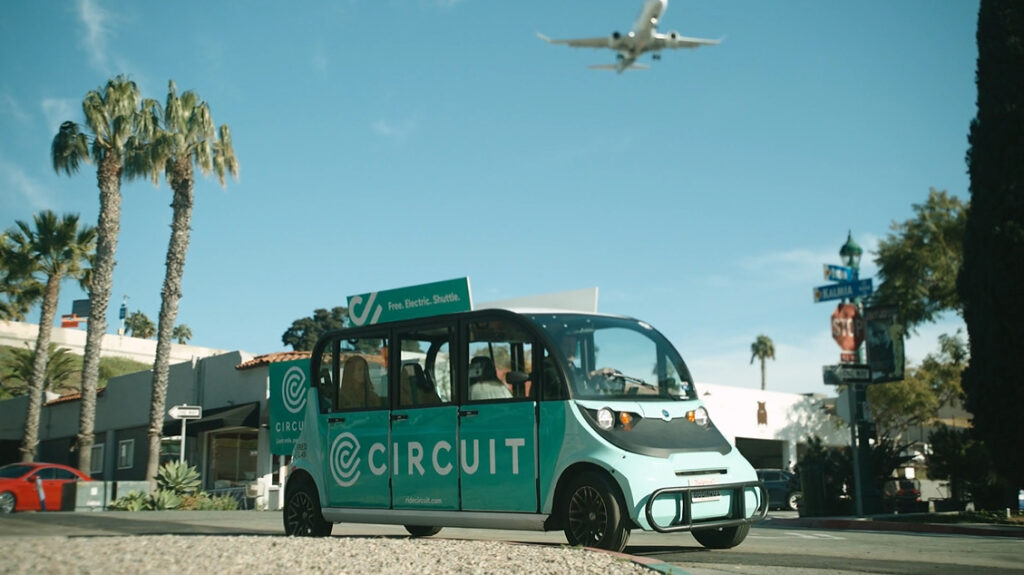
Update, March 6: City staff are currently finalizing the contract for the shuttles, which will come before City Council for final approval in the coming weeks. A start date for the program has not yet been set.
Door-to-door, on demand electric vehicle shuttles are coming to the Coronado Village and Cays as part of a six-month pilot program beginning in March 2024.
Rides will be free during the pilot, which will run through August to assess the demand, efficacy, and environmental impact of the shuttles. The goal is for wait times of 10 minutes or fewer within the village.
The Coronado City Council voted 4-1 at the Sept. 5 meeting to approve the pilot program, which will be run by the micro transportation company Circuit. Mayor Richard Bailey voted in dissent.
“With every single one of the problems we’re solving (with the shuttle),” Bailey said, “it seems like there’s a more viable and economical alternative.”
Circuit proposed a six-month pilot that included eight shuttles for $601,696. The proposal included door-to-door service in the village and fixed route service in the Cays, according to Daniel Kramer, vice president of operations and business development for the west coast at Circuit.
However, council voted to also provide door-to-door service in the Cays, saying they would rather not provide barriers to usage as they gathered data during the pilot. The council also expanded the shuttle’s proposed operating hours on weekends, which would presumably increase costs.
The shuttles will run from 10 am to 9 pm Sunday through Thursday, and from 9 am to 11 pm on Friday and Saturday.
“I’m willing to give this a try,” said Councilmember Casey Tanaka, noting that the door-to-door service may be more beneficial to residents than the often underutilized free summer shuttle, which costs the city about $220,000 annually. “Part of our job as a government is to take our tax dollars and do something interesting to provide amenities to residents.”
Pilots are designed to be dynamic, Kramer said, so the city can adjust the number of vehicles, their operating hours, and routes throughout the program to better assess the city’s demand and needs.
At the program’s conclusion, the City Council will determine whether the program meets Coronado’s needs.
If implemented permanently, a fee may be added for riders. Kramer said the fee leads to greater efficiency and fewer cancellations. Circuit operates shuttles in Oceanside, San Diego, Pacific Beach, and Chula Vista, and is launching in National City next week. Most pilots start free and then add a fee of $2-3 per rider, with caps per group, Kramer said.
All council members agreed that establishing goals with clearly defined metrics was critical in making an informed final decision on the shuttles.
“I don’t see this as a transportation project,” said Councilmember Mike Donovan. “I see it as a way to reduce greenhouse gas emissions, with added benefits of reducing parking and traffic congestion.”
Circuit estimates that 30,000 trips would save nine metric tons of fossil fuel, which is the target reduction outlined in Coronado’s Climate Action Plan. Pilot projections predict 50,000 rides in six months, or 84,000 rides in a year (to account for the off season). However, the council questioned how to accurately estimate just how much impact the shuttle has.
For example, the city’s summer shuttle implemented a survey among riders and found that many patrons would have walked or biked had they not used the shuttle, which runs on a fixed route. But the electric shuttles may be more effective at reducing car trips due to its door-to-door nature convenient to all residents. The city plans to implement a similar survey as it pilots the electric shuttles.
To further snarl the task of measuring impact, reducing a car trip does not necessarily remove an internal combustion engine vehicle from the road: Plenty of people own electric cars.
Councilmember Carrie Downey reported that 254 cars in Coronado have received the electric rebate, and while not all electric vehicles would qualify for it, the number of electric vehicles in Coronado may be lower than expected.
Of course, Downey said, the shuttles also carry quality-of-life increases. Some residents can’t attend events or dine at restaurants if there is insufficient nearby parking, and the shuttles solve that problem. The fleet will include ADA accessible vehicles.
Although council members had their concerns – Tanaka worried that hotel patrons may use the service to the disadvantage of local residents, while Councilmember John Duncan expressed disappointment that Circuit did not find any grants to save the city money on the pilot – they ultimately decided to give the shuttles a chance.
But Bailey remained firm in his position that the shuttle may not be the most economically prudent way to address any of the issues the shuttle impacts.
“If our objective were to make transit more accessible, the cost is estimated at $1.2 million per year to move about 80,000 riders,” Bailey said. “That cost is about $14 per rider.”
Bailey cited rates on Uber to get from Coronado City Hall to the ferry landing at between $5 and $6 per car with a short wait time, noting that the app utilizes dynamic pricing for high-demand timeframes.
“I just find myself asking, ‘Would there be a cheaper alternative?’” Bailey said.
RELATED:




